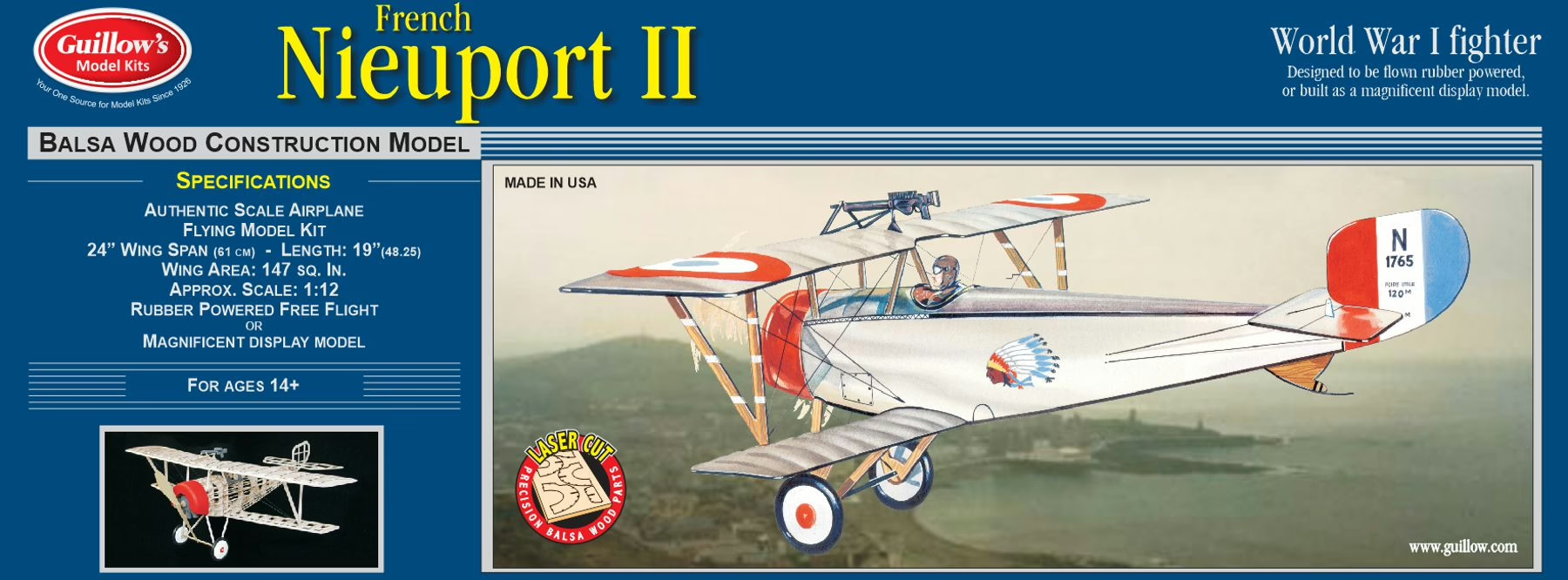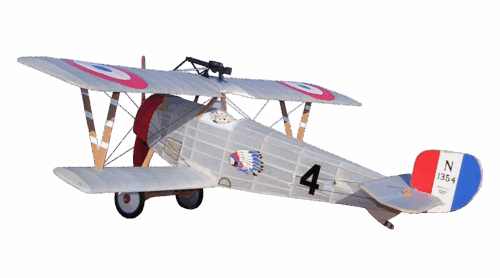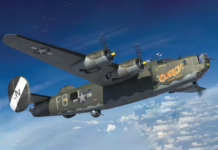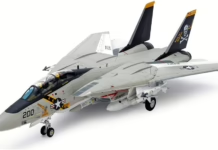Guillow’s legendary WWI fighter gets a modern makeover with laser-cut parts that finally deliver the precision builders deserve—but its notorious short nose still demands respect.
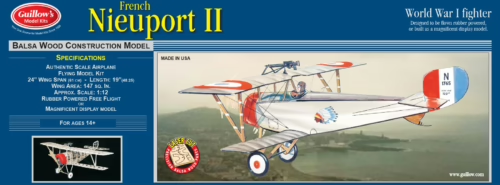
The modeling world has changed. Walk into any hobby shop today, and you’ll find shelves stacked with ready-to-fly foam fighters that cost as much as this kit yet offer none of the satisfaction. But for those of us who remember the smell of balsa cement and the pride of building something real, Guillow’s Nieuport 11 “Bébé” (Kit #203) represents something different—a bridge between old-school craftsmanship and modern manufacturing precision. The real question isn’t whether this kit belongs in your workshop. It’s whether you’re ready for what it demands.
In April 1916, American volunteers with the Lafayette Escadrille took to French skies in these nimble fighters, and the “Bébé” became an icon of early aerial combat. That heritage lives on in this 1/12 scale kit, but don’t let nostalgia cloud your judgment. This isn’t your father’s frustrating die-cut nightmare. Guillow’s has reinvented this classic with laser-cut balsa parts that fit together with precision that would’ve seemed impossible a decade ago. The catch? The same design flaw that plagued the original—a brutally short nose—remains the kit’s defining challenge.
AT A GLANCE
| Specification | Detail |
|---|---|
| Model | Guillow’s Nieuport 11 “Bébé” |
| Kit Number | 203 |
| Scale | 1/12 (approximately) |
| Wingspan | 24 inches (609mm) |
| Length | 19 inches (482mm) |
| Wing Area | 147 sq. in. |
| Construction | Stick-and-Tissue (Balsa Frame & Tissue Covering) |
| Key Feature | Laser-Cut Balsa Parts |
| Intended Power | Rubber-Powered Free Flight or Static Display |
| Price | $106.99 |
| Pilot Skill Level | Intermediate to Advanced |
| Time to Assemble | 30-60+ hours (depending on experience and detail level) |
What Sets This Kit Apart
The transformation from Guillow’s old die-cut days to modern laser precision isn’t marketing hype—it’s the difference between a kit that fights you and one that rewards skill. Builder after builder reports the same revelation: “Fit of parts is awesome.” Another noted being “amazed at how everything fit so precisely.” This isn’t slight improvement—it’s a fundamental shift in what’s possible with a traditional balsa kit.
The laser-cut sheets deliver clean, burr-free edges and parts that pop out effortlessly. Gone are the days of die-crushed balsa that splintered when removed or formers that never quite matched the plans. Every rib, former, and stringer arrives with crisp, consistent cuts that make alignment straightforward and glue-up satisfying.
But here’s where reality intrudes on the celebration: the wood itself remains a wildcard. Some builders praise the “high quality balsa,” while others have historically complained about “crummy” or “ironwood” dense stock. This isn’t contradictory—it’s intentional. The laser-cutting process works best with consistent, denser wood. For a display model or an RC conversion, this denser balsa is actually an asset, providing strength and durability. For free-flight? It’s a disaster. One experienced builder confirmed the kit wood was “pretty heavy” and had to contact Guillow’s for lighter replacement stock.
The kit includes an impressive array of finishing components: a vacuum-formed nose cowl, scale dummy rotary engine, pilot figure, machine gun, two 2-inch wheels, and two comprehensive decal sheets for authentic markings. These plastic parts aren’t aftermarket-quality, but they’re excellent starting points. One enthusiastic builder elevated his model by adding Williams Brothers cylinder detail kits to the engine, scratch-building an interior, and using fishing line for flying wires—proof that this kit rewards those willing to push beyond the box contents.
The Build Experience: Old-School Technique Meets Modern Precision
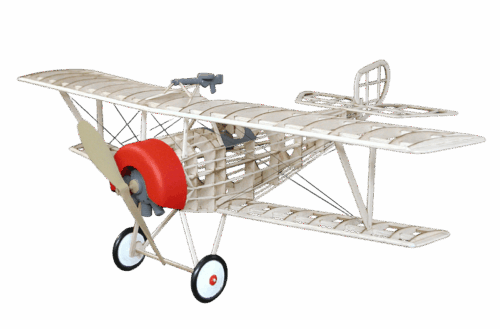 Let’s be direct: this kit assumes you know what you’re doing. There’s no instruction booklet walking you through every step. Instead, you get full-size plans and a basic assembly guide. If you’ve never built a stick-and-tissue model, this biplane will humble you fast.
Let’s be direct: this kit assumes you know what you’re doing. There’s no instruction booklet walking you through every step. Instead, you get full-size plans and a basic assembly guide. If you’ve never built a stick-and-tissue model, this biplane will humble you fast.
Traditional balsa construction demands a proper workflow. You’ll need a flat, pinnable building surface—a sheet of ceiling tile or thick cork board works perfectly. Cover the plans with wax paper to prevent gluing your model permanently to the paper. Use T-pins to hold components in alignment as the glue dries, pinning around parts rather than through them to avoid splitting the wood.
The fuselage uses Guillow’s classic “half-shell” method: you build each side directly over the plans, then join them together. This technique is time-tested but inefficient by modern standards. One expert noted the method “automatically involves far more wood than what is needed,” contributing to the model’s notorious weight problem. A skilled builder will know to drill lightening holes in the formers and carefully assess each piece before installation. Follow the plans verbatim as a novice, and you’ll build a beautiful brick that struggles to leave the ground.
The biplane configuration adds complexity. Both wings require careful tissue covering, proper alignment is critical for flight characteristics, and the interplane struts need precise placement. This is fiddly work that rewards patience and punishes haste. Don’t expect to knock this out over a weekend—budget 30 to 60 hours minimum, more if you’re adding custom details or modifications.
The Elephant in the Nose: That CG Problem
Here’s what nobody putting this kit in your hands wants to say upfront: as designed, the Nieuport 11 has a severe, inherent, tail-heavy balance problem. The short nose—historically accurate to the original’s light rotary engine—creates insufficient moment arm to counterbalance the tail’s weight. This makes the model dynamically unstable and “hard to get flying.”
For rubber-powered free-flight, this is a deal-breaker unless you’re an expert-level builder willing to strip out the kit’s wood and rebuild with competition-grade light balsa. Even then, you’ll need “a lot of clay” in the nose to achieve proper center of gravity. One experienced flier bluntly called it “not a simple task” and warned the model is “way too heavy” for its intended rubber-power application.
But here’s the twist that changes everything: this design flaw becomes the kit’s greatest asset for an electric RC conversion. The short nose creates the perfect space to pack a brushless outrunner motor, ESC, and battery up front exactly where the weight is needed. What makes this model nearly impossible as free-flight makes it brilliant as a micro RC platform.
RC Conversion: The Kit’s True Calling
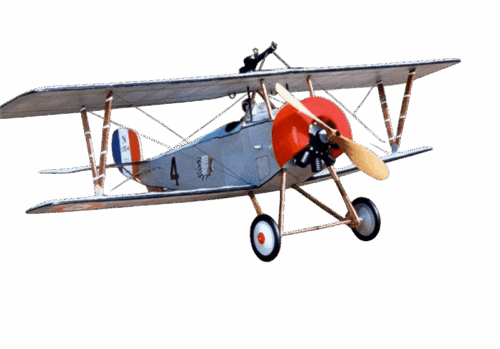 For intermediate-to-advanced modelers experienced with micro RC conversions, the Nieuport 11 represents a famous and satisfying challenge. The conversion requires methodical planning before the first piece of balsa is glued. You’re not just building the kit—you’re re-engineering it.
For intermediate-to-advanced modelers experienced with micro RC conversions, the Nieuport 11 represents a famous and satisfying challenge. The conversion requires methodical planning before the first piece of balsa is glued. You’re not just building the kit—you’re re-engineering it.
The essential modifications include:
Electronics Integration: Before assembling the fuselage, you must plan mounting rails for servos and create a battery tray. The top cowl typically gets modified into a magnetic removal panel for battery access.
Control Surface Liberation: The plans show fixed control surfaces. You’ll need to carefully cut the ailerons, elevator, and rudder free from the framework, then add your own balsa leading edges to these now-movable surfaces.
Firewall Installation: The nose section designed for a rubber motor gets scrapped. You’ll build a proper plywood firewall to mount a brushless outrunner motor.
For a 24-inch wingspan WWI conversion, the electronics package has been proven by multiple successful builds. Based on similar 24-inch Guillow’s conversions, the recommended setup includes:
- Motor: Suppo A1504 or Emax CF2805 2840kV (15-20g brushless outrunner)
- ESC: 10-15A brushless (like Castle Talon 15)
- Receiver: 4-6 channel micro (any modern park flyer receiver)
- Servos: 3-4 micro servos, 5-9g class (such as Hitec HS-40 or HS-55)
- Battery: 2S 300-480mAh LiPo
- Propeller: 5×5 to 6×4 (matched to your motor’s kV rating)
The beauty of this configuration is that every component sits exactly where it’s needed for proper balance. The motor, ESC, and battery fill the short nose with useful weight, solving the CG problem that makes the kit impossible as free-flight. The result is a unique, head-turning micro RC biplane that flies with genuine WWI character.
Who Should Buy This Kit
- The Experienced Stick-and-Tissue Builder: If you love traditional balsa construction, find satisfaction in a clean workbench covered with carefully organized parts, and want a complex, rewarding months-long project, this delivers. The laser-cut precision makes the actual building enjoyable, and the subject matter is historically rich.
- The WWI Scale Enthusiast: For display purposes, this kit is outstanding. The included scale details provide an excellent foundation, and the accurate outline captures the “Bébé’s” distinctive look. With patience and some super-detailing, you can build a museum-quality replica worthy of a display case.
- The RC Conversion Specialist: This is your sweet spot. The Nieuport 11 has earned legendary status among micro RC converters precisely because its greatest weakness becomes its greatest strength. For the modeler experienced with small-scale electric conversions, this represents a fascinating technical challenge with a genuinely rewarding payoff.
This kit is NOT for:
- First-Time Balsa Builders: We can’t emphasize this enough—don’t start here. The biplane configuration is inherently complex, the traditional construction methods require specialized tools and techniques, and the kit is unforgiving of mistakes. Start with a simple Guillow’s 500-series high-wing trainer, learn the fundamentals, then graduate to this.
- Rubber-Powered Free-Flight Fliers: Unless you’re genuinely expert-level, willing to replace all the kit’s wood with contest-grade light balsa, and prepared to extensively modify the nose for balance, you’re setting yourself up for frustration. This kit builds heavy and balances poorly for its intended rubber-power mission.
Value Proposition
At $106.99, this kit isn’t cheap—especially when compared to ready-to-fly foam models at similar price points. But that comparison misses the point entirely. This isn’t a product; it’s a project. The price buys you dozens, potentially hundreds, of hours of engaging hobby time. The value is in the journey, not instant gratification.
When properly compared against other high-end, laser-cut scale kits from manufacturers like Dumas or Brodak, the pricing is competitive and fair. Guillow’s adds genuine long-term value by offering replacement parts individually—everything from decals to balsa sheets. Crash your model? You can rebuild it without buying an entirely new kit.
For a display builder, it’s money well spent. For an RC converter, it’s a famous challenge that delivers a unique flying model. For a rubber-power enthusiast? You’re paying premium price for an uphill battle.
The Verdict
The Guillow’s Nieuport 11 (Kit #203) stands as a testament to how modern manufacturing can revitalize a classic kit without losing its soul. The laser-cut parts are genuinely excellent, delivering precision and fit quality that transforms the building experience. The subject matter is iconic and historically significant. The included scale details and comprehensive decals provide everything needed for an authentic finish.
But this kit demands honesty about its limitations. The short nose creates a severe center-of-gravity challenge that makes it “not a simple task” for rubber-powered flight. The dense balsa, while perfect for durability, adds weight that compounds the balance problem. This is emphatically not a beginner’s kit—the complexity will overwhelm a novice, and the traditional construction methods require both skill and specialized tools.
As a static display model: Highly Recommended. The bones are excellent, the details are comprehensive, and the subject matter is inspiring. This will build into a beautiful showpiece.
As a rubber-powered flyer: Not Recommended. The design works against you at every turn. Only expert builders willing to extensively modify and rebuild with lighter materials should attempt this application.
As an electric RC conversion: Highly Recommended. This is where the kit truly shines. The very design flaw that ruins its free-flight potential becomes the perfect solution for RC, providing exactly the nose volume needed for batteries and electronics while solving the balance equation. For the experienced converter, this is a must-build that delivers a genuinely unique flying model.
You’re not buying this kit for what’s in the box. You’re buying it for the challenge it represents and the pride you’ll feel when you solve it. That’s the real precision revolution—not just in how the parts are cut, but in how they inspire you to become a better builder.
Pros & Cons
PROS:
- Laser-Cut Precision: The modern manufacturing delivers clean, accurate parts with excellent fit that makes assembly genuinely enjoyable compared to old die-cut kits.
- Historic Significance: The Nieuport 11 “Bébé” carries genuine aviation heritage as the fighter flown by the Lafayette Escadrille, making it a meaningful build for WWI enthusiasts.
- Brilliant RC Conversion Platform: The problematic short nose becomes the perfect solution for electric conversion, providing ideal space for motor, ESC, and battery exactly where nose weight is needed.
- Comprehensive Scale Details: Included vacuum-formed plastic parts, scale engine, pilot figure, machine gun, wheels, and two decal sheets provide excellent finishing components.
- Builder’s Reward: Completing this challenging kit delivers immense satisfaction that ready-to-fly models cannot match, connecting you to traditional modeling craftsmanship.
CONS:
- Severe CG Challenge: The historically accurate short nose creates a brutal tail-heavy balance problem, making the model “hard to get flying” without significant nose weight or complete re-engineering.
- Heavy Balsa Stock: The wood, while well-cut, is often reported as dense and heavy—excellent for durability but making the model “way too heavy” for its intended rubber-powered flight mission.
- Not Beginner-Friendly: This complex biplane demands specialized tools, techniques, and experience. It’s “fiddly” and unforgiving, certain to overwhelm first-time balsa builders.
- Difficult Free-Flight Application: As designed, this kit is “not a simple task” for rubber-power, requiring expert-level modifications including wood replacement and extensive nose ballast for even marginal flights.
Frequently Asked Questions
Q: Is this suitable for my first balsa kit?
A: Absolutely not. We strongly recommend against this as an introduction to balsa building. The biplane configuration adds complexity, the traditional stick-and-tissue construction requires specialized tools and workspace, and the design is unforgiving of beginner mistakes. Start with a simpler Guillow’s 500-series high-wing model to learn fundamentals before tackling this intermediate-to-advanced kit.
Q: Can this really fly with the included rubber band?
A: Technically possible but practically difficult. The kit builds inherently tail-heavy due to its short nose, and the provided balsa tends toward the heavy side. You would need expert-level skills, likely replacement of the kit wood with lighter contest-grade balsa, and substantial nose weight (modeling clay) to achieve proper balance. Even then, flights will be short and heavy. This is not a good choice for casual rubber-powered flying.
Q: What exactly is the “short nose problem”?
A: The nose section is too short to provide sufficient moment arm to counterbalance the tail’s weight. In aerodynamic terms, there isn’t enough distance between the center of gravity and the tail surfaces, making the model dynamically unstable and tail-heavy. You must add significant weight to the nose (via modeling clay for rubber-power, or via motor/battery for RC conversion) to achieve proper balance.
Q: What electronics do I need for an RC conversion?
A: For a successful 24-inch wingspan conversion, we recommend: a 15-20g brushless outrunner motor (Suppo A1504 or Emax CF2805 2840kV), 10-15A brushless ESC, 4-6 channel micro receiver, 3-4 micro servos (5-9g class), 2S 300-480mAh LiPo battery, and a 5×5 to 6×4 propeller matched to your motor’s specifications. All electronics should be planned and mounting positions designed before you begin assembly.
Q: What tools and supplies do I absolutely need?
A: Essential tools include: a large flat building board (cork board or foam ceiling tile), T-pins, sharp hobby knife (X-Acto or similar), various grits of sandpaper (220-400 grit), and proper adhesives. You’ll need balsa cement or wood glue for structural joints, CA (cyanoacrylate) glue for tack-welding, and either dope or 50/50 white glue-water mixture for applying tissue covering. Don’t attempt this build without these fundamental supplies.
Q: Can I order replacement parts if I damage something?
A: Yes. Guillow’s offers individual replacement parts for purchase, including balsa sheets, decals, plastic components, and covering tissue. This is a significant value-add compared to many manufacturers—a crash or building mistake doesn’t mean buying an entirely new kit.
Q: How long will this take to build?
A: Budget minimum 30-60 hours for an experienced builder following the plans. If you’re adding custom details (scratch-built interior, enhanced rigging, weathering), planning an RC conversion, or relatively new to balsa construction, expect the timeline to extend to 80-100+ hours. This is a months-long project, not a weekend build.

Key Takeaways
- Laser-cut precision transforms this classic kit: Modern manufacturing delivers exceptional part fit, making assembly satisfying rather than frustrating compared to old die-cut versions.
- The short nose creates opposite outcomes: This design flaw makes the kit extremely difficult for rubber-powered flight but ideal for RC conversion, where electronics perfectly solve the balance problem.
- Not beginner territory: This intermediate-to-advanced kit demands specialized tools, proper workspace, and stick-and-tissue experience. First-time builders should start elsewhere.
- Value depends on application: Excellent choice for display builders and RC converters at $106.99, but poor value for rubber-powered enthusiasts who face an uphill engineering challenge.
- Heritage meets modern capability: The iconic WWI “Bébé” subject combined with precision-cut parts creates a rewarding project for skilled builders seeking authentic craftsmanship.


